

SMALL TOWN, BIG BEACH

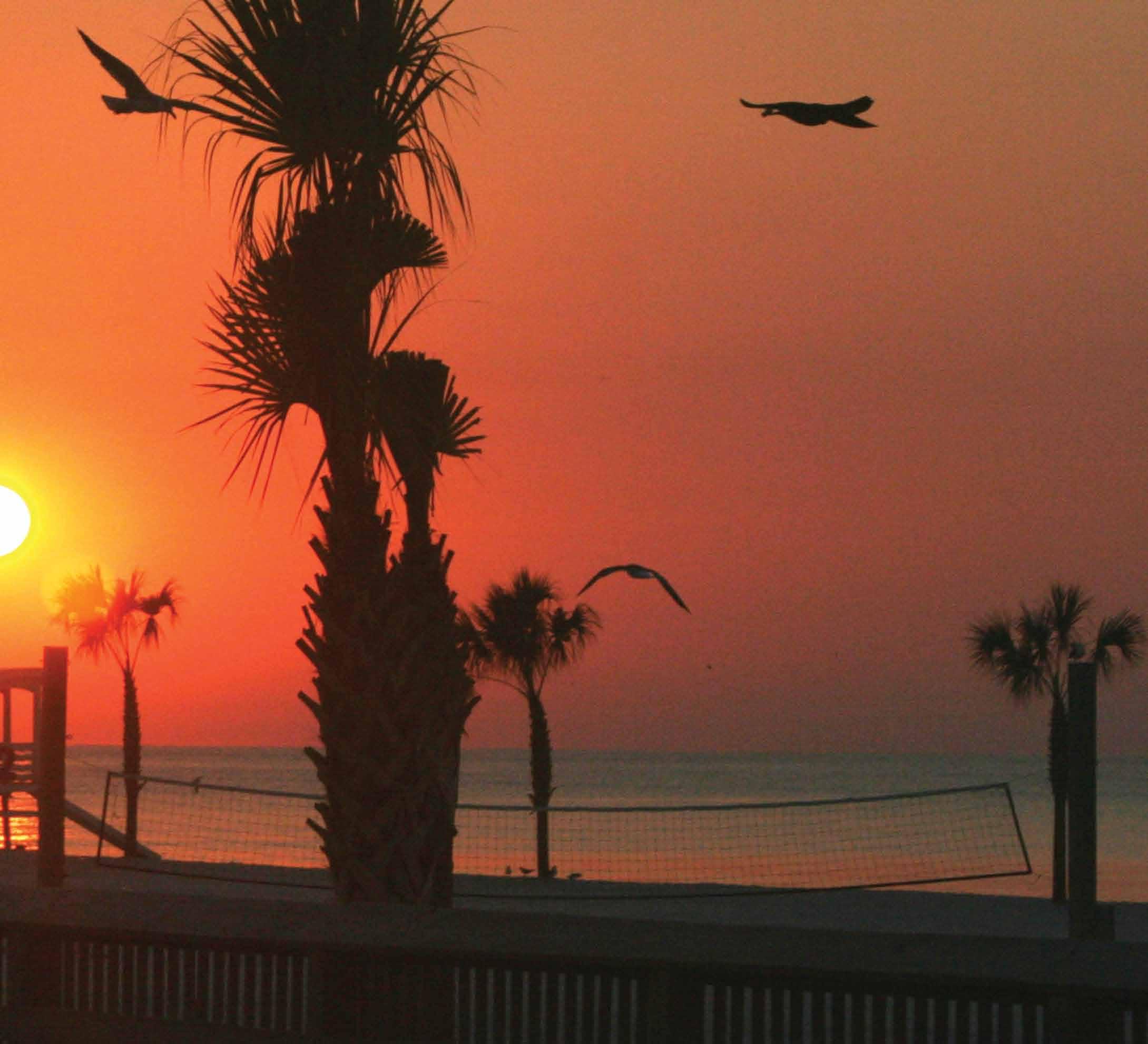

1950s, City of Gulf Shores Fire Department Truck
small town, big beach
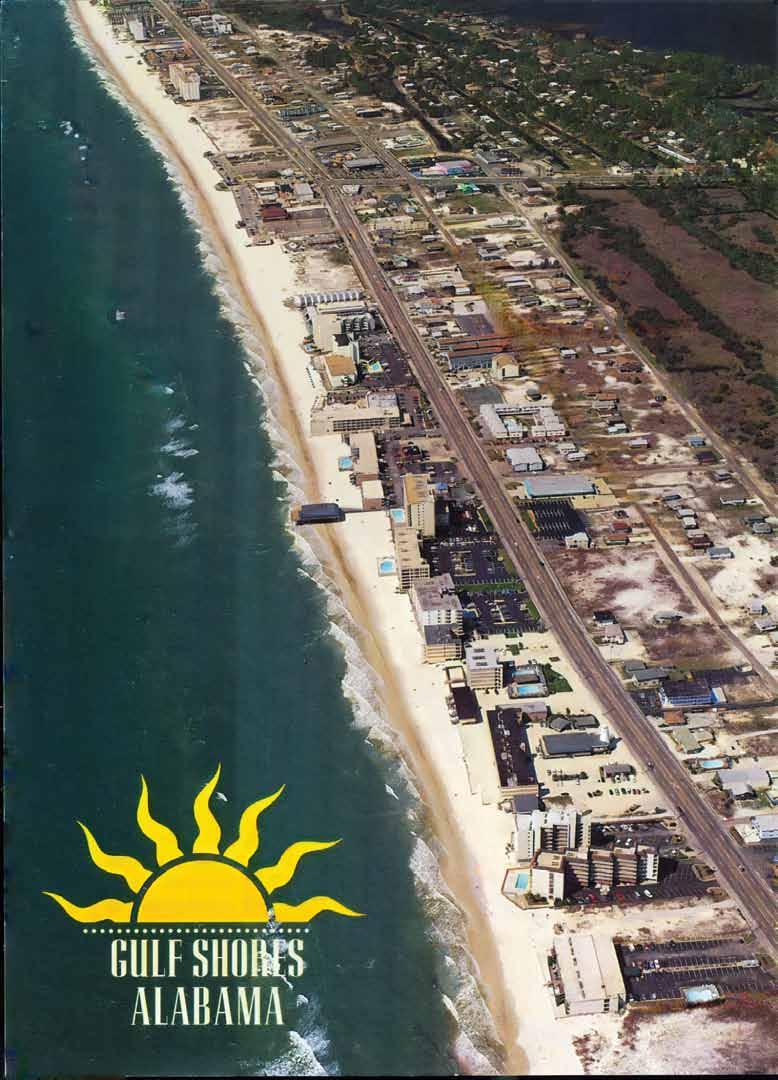







Published by PV Publications
©2025 City of Gulf Shores, Alabama
All other rights reserved. No part of this book may be reproduced, stored in a retrieval system, or transmitted in any form or by any means, mechanical, electronic, photocopying, recording, or otherwise, without permission from the City of Gulf Shores, Alabama
ISBN: 978-1-7372192-2-4
Written and curated by PV Publications, Kristin Borden, in partnership with the City of Gulf Shores
Graphic design by Lane Bullard and PV Publications
This book was made possible thanks to the invaluable insight and contributions of Claude O’Connor, the Ward Family, the Gulf Shores Museum and many others who, over the years, have preserved and protected the history of this area — including Joy Busken and the collections compiled by the Gulf Shores Woman’s Club — whose materials formed the foundation for much of what is presented here.
For details, contact: www.pvpublications.com
PV Publications
PO Box 4752, Palos Verdes Peninsula, CA 90275 kristin.borden@pvpublications.com
For more information about the City of Gulf Shores: www.gulfshoresal.gov
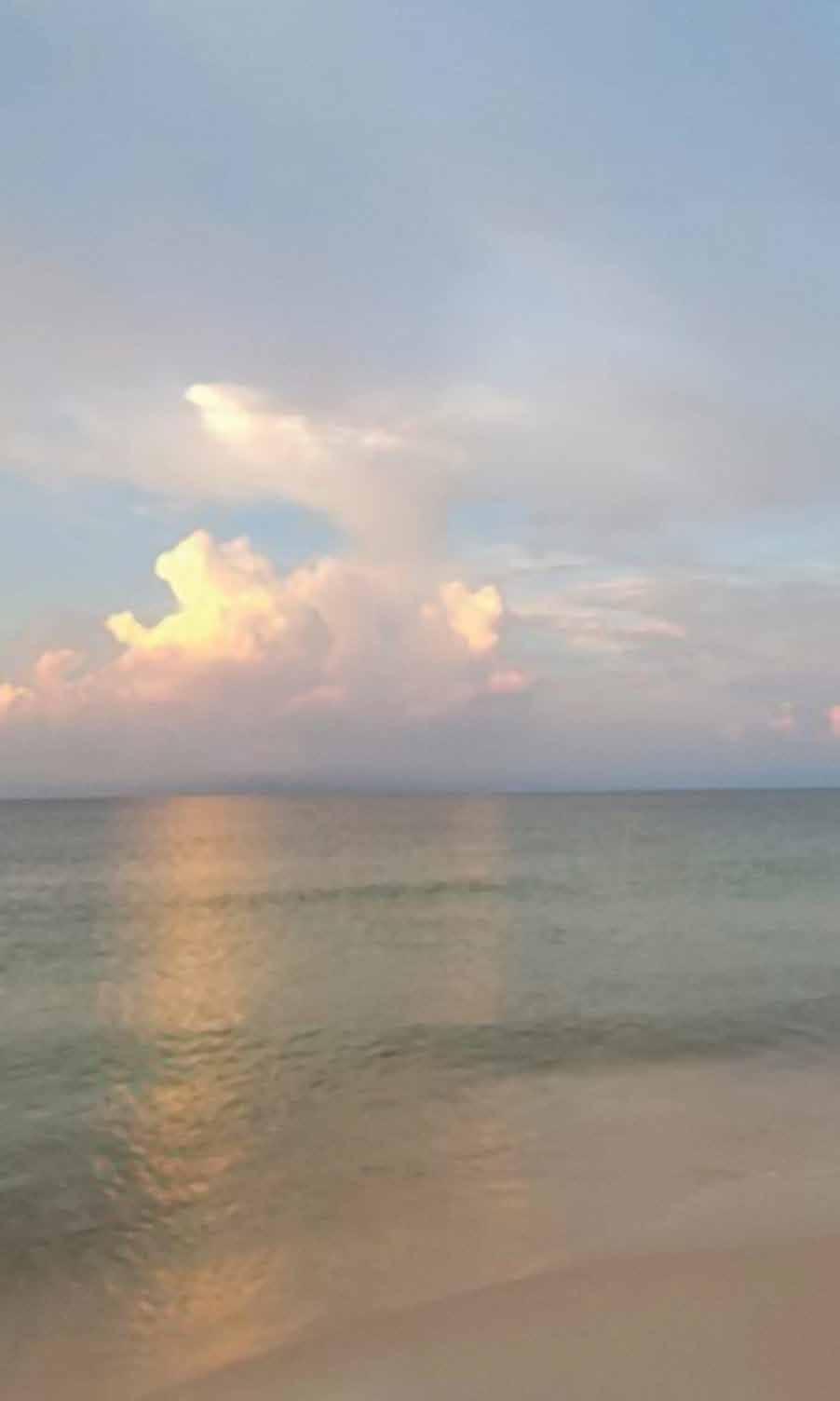


Robert Craft has devoted the past two decades to serving the City of Gulf Shores. He was elected as the city’s ninth mayor in August 2008, following four years of service on the Gulf Shores City Council from 2004 to 2008.
As mayor, Craft has focused on enhancing the quality of life for all residents. Under his leadership, the city has made tremendous strides, including more than $272 million in capital improvements and the acquisition of $76 million in grant funding. Key accomplishments during his tenure include the establishment of Gulf Shores City Schools, the development of a state-of-the-art freestanding emergency room, the revitalization of Gulf State Park and Lodge, the addition of the Auburn University Education Complex, and significant infrastructure improvements across the city.
In addition to his role as mayor, Craft is one of 10 Alabama leaders serving on the RESTORE Council, which manages the distribution of $750 million from the Deepwater Horizon oil spill settlement for projects in Mobile and Baldwin counties. He also serves on the boards of the Gulf Coast Convention and Visitors Bureau, Gulf Shores Utilities, and the Gulf Coast Center for Ecotourism. He is an active member of the Gulf United Metro Business Organization (GUMBO).
Prior to his public service, Craft had a successful entrepreneurial career in agribusiness and real estate development. In 1986, he partnered with his parents, Jane and R.C., to develop Craft Farms—a master-planned residential community featuring nine neighborhoods, two Arnold Palmer-designed golf courses, a Courtyard by Marriott hotel, and Cypress Point Condominiums. He also founded Craft Turf Farms, a 2,000-acre operation providing premium turf grass to builders and landscapers since 1974.
Craft is a graduate of Foley High School and Auburn University, where he earned a degree in Agricultural Science. He is married to Trudy, a Mobile native, and together they share a blended family of four children and ten grandchildren.
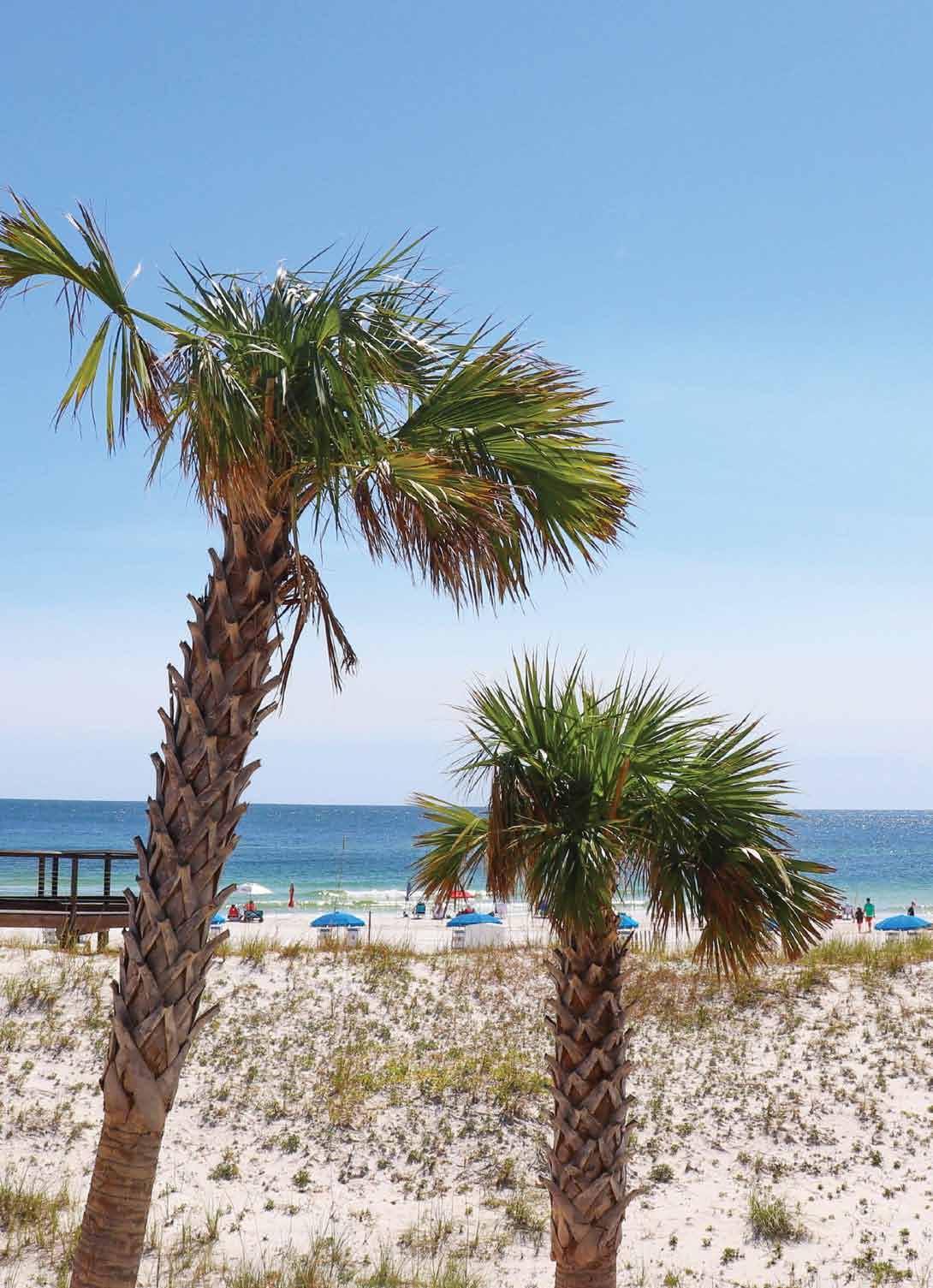
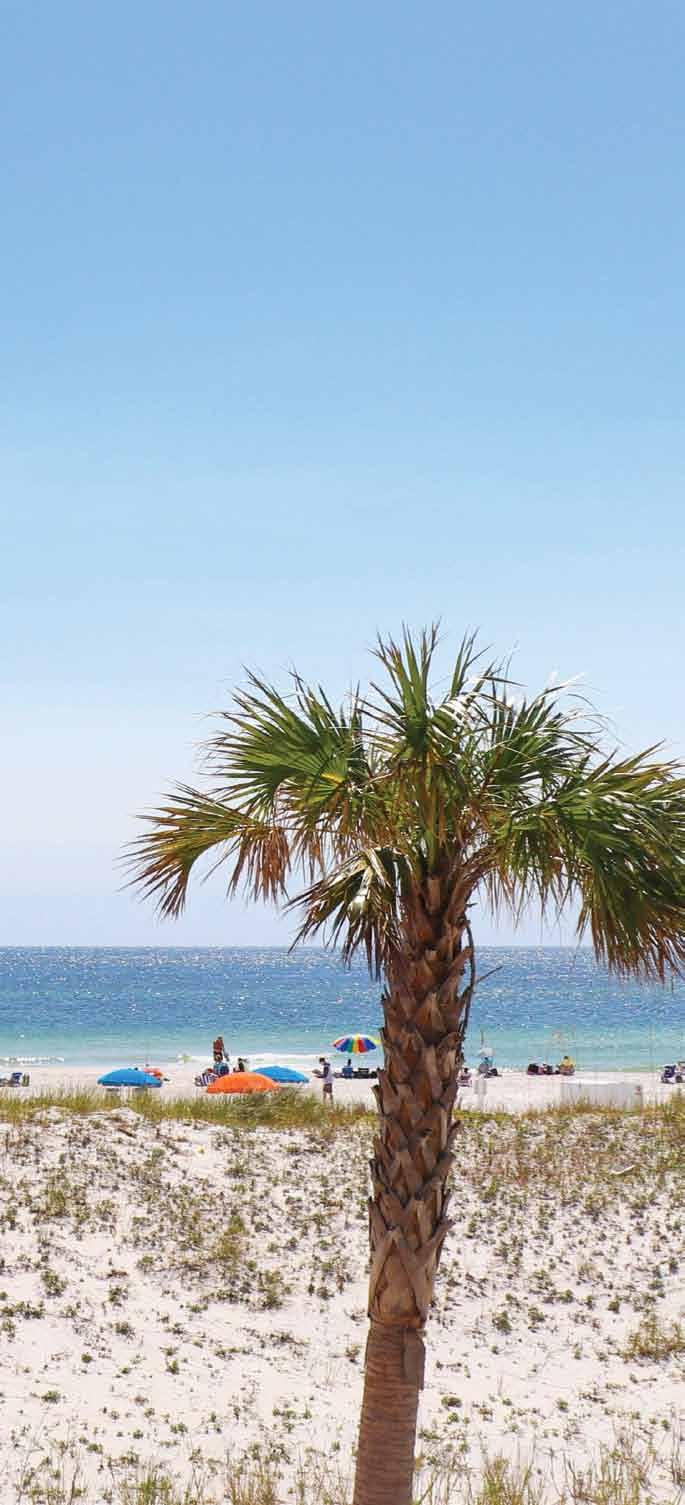
Heritage n Honoring Our
On behalf of the residents, staff, and City Council, I am honored to introduce you to and warmly welcome you to Gulf Shores, Alabama.
Gulf Shores has become Alabama’s number one tourist destination and is home to some of the most picturesque beaches in the country. Whether you prefer a leisurely walk along our miles of coastline, a fitness-inspired trek down one of our many trails, or an exhilarating boat ride across our backwaters, bays, and lagoons, Gulf Shores offers breathtaking moments around every corner.
Gulf Shores blends its small-town, family-friendly atmosphere with a thriving big-beach economy, providing wholesome Southern hospitality and first-class attractions. Enjoy fresh seafood at locally owned restaurants, take a stroll through our charming shops, and explore the natural beauty of our parks, trails, and beaches.
Each year, millions of guests fall in love with our coastal community, with many developing long-standing family traditions of relaxing and reconnecting with loved ones while enjoying our expansive, white-sand beaches. Our city also proudly hosts numerous National Championship softball, baseball, track, and soccer tournaments at the state-of-the-art Gulf Shores Sportsplex and surrounding facilities—further establishing our community as a premier destination for both leisure and competitive events.
Whether you are seeking a beach escape for a day or a lifetime, Gulf Shores is an uncomplicated beach community, making it the perfect place for relaxed living. Some, the lucky ones, choose to stay—drawn in by the beauty, the pace, and the sense of belonging that makes Gulf Shores feel like home. So, what are you waiting for? Come and explore all that Gulf Shores has to offer and experience what our Small Town, Big BeachTM is all about.
Sincerely, Robert Craft Mayor, City of Gulf Shores (2008-present)


Introduction
Nestled along the Alabama Gulf Coast, Gulf Shores is a place where white-sand beaches meet laid-back coastal charm. It has the heart of a small town—filled with familyfriendly activities and a strong sense of Southern hospitality. Neighbors still look out for one another, and traditions of kindness and connection remain at the core of this close-knit community.
Even during the bustling summer months, when the beaches fill with vacationers, Gulf Shores stays true to its roots. It offers a welcoming, authentic atmosphere that feels like home.
Over the years, Gulf Shores has grown into one of the South’s most desirable small-town destinations. Consistently ranked among the nation’s top beaches, it boasts miles of sugar-white sand and diverse ecosystems, making it a paradise for both relaxation and adventure.
But Gulf Shores is more than just a beloved vacation spot—it’s a thriving community with a rich history. The completion of the Intracoastal Waterway in 1937 and the opening of Gulf State Park in 1939 helped attract new residents and visitors alike. Before that, it was home to a small fishing village that dates back to the early 1800s. The town got its first post office in 1947 and officially became incorporated as a town with 120 residents in 1958. What began as a community rooted in shrimping, oystering, and fishing has since evolved into a vibrant resort destination shaped by tourism and real estate. While the beaches remain the biggest draw, there’s no shortage of
things to do. Visitors can take scenic cruises, watch dolphins gliding through the waves, or explore miles of hiking and biking trails. Families love the Alabama Gulf Coast Zoo, known for its hands-on animal encounters, while outdoor enthusiasts enjoy fishing, golfing, and the nature trails at Gulf State Park. For a more peaceful retreat, Bon Secour National Wildlife Refuge provides a sanctuary for sea turtles and migratory birds, and history buffs can step back in time at Fort Morgan, a 19th-century landmark overlooking Mobile Bay.
In recent years, Gulf Shores has also become a premier destination for sports. The City hosts major events like NCAA Beach Volleyball National Championship and numerous softball, baseball, track, and soccer tournaments at the Gulf Shores Sportsplex. With top-tier facilities and a stunning coastal backdrop, it attracts athletes and fans from across the country.
Whether you’re seeking adventure or a place to unwind, Gulf Shores offers something for everyone with its unique blend of history, hospitality, and scenic beauty. The City remains committed to thoughtful growth, balancing development with sustainability through conservation efforts, community engagement, and smart planning. This dedication helps preserve the coastal charm that draws both longtime residents and first-time visitors alike. Every sunrise over the Gulf and every walk along the shoreline serves as a reminder of the enduring natural beauty and welcoming spirit that make Gulf Shores a one-of-a-kind destination.

1939, Highlights and Highways of Baldwin County, Alabama, by Walter Overton

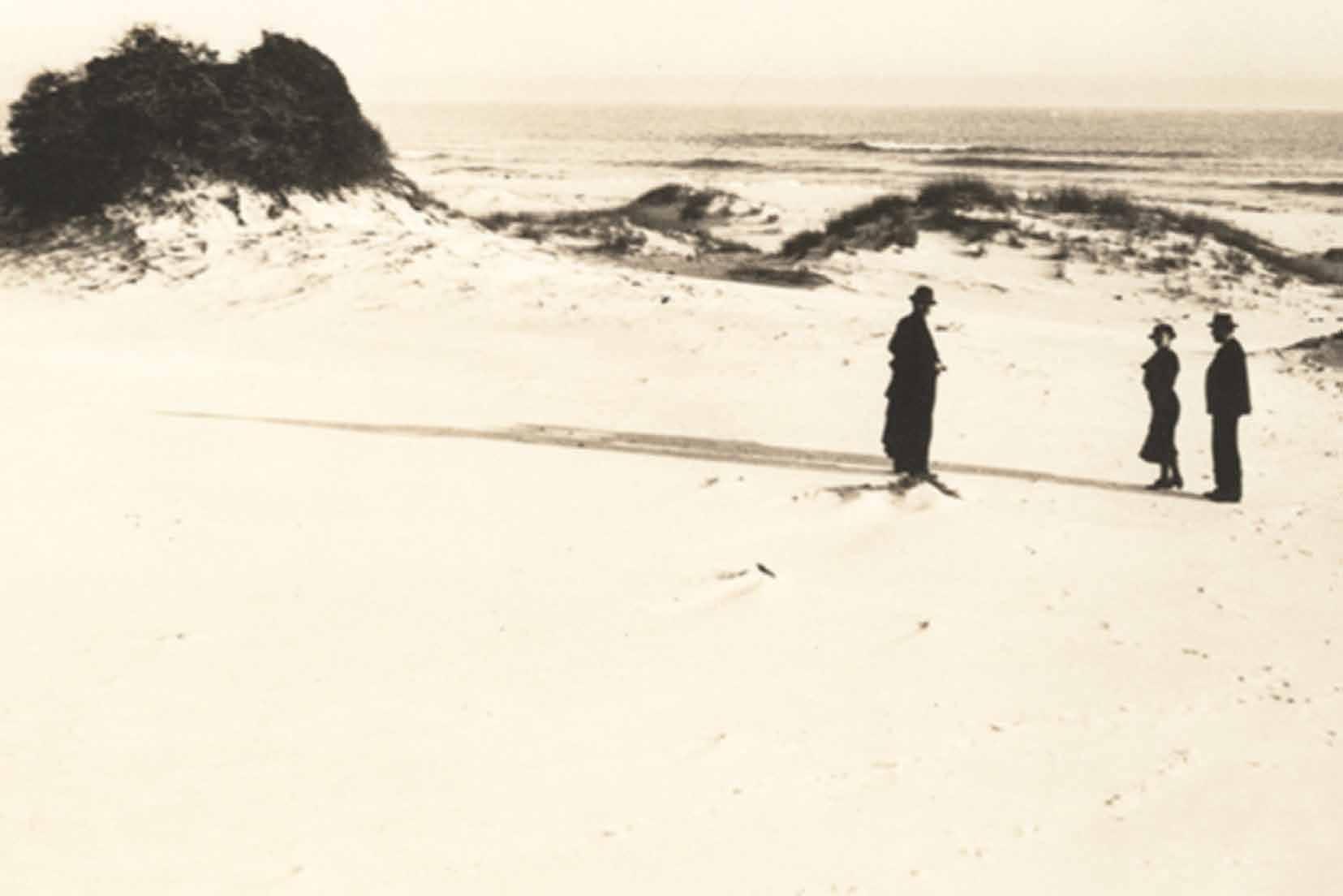
1920s, Gulf Shores Beach

Before the City: The Land that Shaped
Gulf Shores
As the sun rises over the Gulf Coast, the pristine white sand beaches of Gulf Shores evoke a sense of timeless beauty. Yet this coastal landscape hasn’t always looked as it does today. To fully appreciate the evolution of Gulf Shores, one must first delve into the deeper history that shaped this region long before it became the beloved coastal community we know.
In the aftermath of the Ice Age, the Gulf of Mexico stretched much farther south, and the land now known as Gulf Shores was covered in dense forests. Archaeological evidence suggests that human habitation began here around 11,500 years ago, with organized civilizations emerging by 1000 BC. Among them were the Mississippian tribes, who left behind shell and burial mounds— silent testaments to their presence and culture.
These early inhabitants were far from isolated. They were part of an expansive trade network, exchanging goods across vast distances. Around 566 AD, they even constructed a hand-dug canal to link the region’s waterways, improving transportation and trade. Often referred to as the “Indian Ditch,” this canal has become a valuable archaeological discovery. Portions have been partially rediscovered, offering rare insights into the complexity of life in the region. Local historian Harry King’s investigations revealed artifacts from across the continent—arrowheads, copper, and obsidian—highlighting Gulf Shores’ place in a broad prehistoric trade system. In 2023, under the direction of Wade and Pat Ward, The George C. Meyer Foundation donated the Indian Ditch to The Archaeological Conservancy to ensure its continued protection and study.
By the 17th century, European settlers began to arrive. While few established permanent homes directly on the beach due to poor soil conditions, nearby inland areas offered rich, fertile ground. These fertile lands in close proximity to the beach eventually contributed to Baldwin County’s longstanding reputation
as an agricultural hub. For many years, it was commonly referred to as “the agricultural county,” a title that speaks to the region’s deep farming roots. Though the sandy beachfront proved unsuitable for cultivation, adjacent inland areas—now within today’s Gulf Shores city limits—continued to support agricultural use well into the mid-20th century. One noteworthy example came in 1953, when R.C. and Jane Craft, along with their son Robert, began cultivating millions of potatoes and gladiolas in the area now known as Craft Farms. Their success further underscored the richness of the local soil just miles from the coast, and some of that land continues to be farmed to this day. Their son, Robert Craft, is the current mayor of Gulf Shores, continuing the family’s legacy of shaping the community.
It wasn’t until the 1906 hurricane reshaped the coastline— carving out the striking white sand beaches we now associate with Gulf Shores—that the area began to take on its identity. In the years that followed, the 20th century ushered in development. By the 1920s, very modest hotels and a few homes had begun to appear and by the 1950s, the start of a new chapter began, signaling the beginning of an evolution to what it is today. Once a quiet fishing and farming area, Gulf Shores gradually transformed as its natural beauty—with calm waters and refreshing breezes— began attracting new residents and visitors. The foundation was laid for the vibrant coastal destination that Gulf Shores has become.
Today, the legacy of that land endures. According to the U.S. Census Bureau, Baldwin County is now the fourth most populous county in Alabama and ranks second in median household income, behind only Madison County, home to Huntsville. This remarkable growth is a testament to the enduring appeal of Gulf Shores and the surrounding area—a community shaped not only by time and progress, but by the very land that made it possible.

1950s, the end of West Beach Road

the early days
1800s
• A small fishing community is established.
1834
• Fort Morgan is completed.
1918
• Shrimping becomes a prominent industry, led by Little Lagoon families such as the Callaways, Wallaces, Nelsons, Childresses, Plashes, and many others.
1920s
• The first hotel opens in the area.
• Local fishermen begin offering one-day fishing charters.
• The first corduroy road is completed, leading to the beach. These roads were constructed by laying logs lengthwise through swampy areas, then covering them with sand and soil, creating a patterned effect resembling corduroy.
• In 1921, George C. Meyer establishes the first homestead south of the Little Lagoon.
1934
• The Civilian Conservation Corps (CCC) begins constructing buildings and trails in Gulf State Park.
1937
• The Intracoastal Waterway is completed, improving accessibility and encouraging commercial trade.
1939
• Gulf State Park opens with cabins and a beachfront casino.
1946
• Bus service from Mobile to Gulf Shores begins, increasing tourism.
1947
• The First Gulf Shores Post Office opens.
1950s
• In 1956, residents of Gulf Shores began petitioning for incorporation, seeking official recognition as a municipality. After two years of efforts, the Alabama Supreme Court granted the incorporation in 1958, officially establishing Gulf Shores as a town.


Stretching 32 miles from Mobile Bay and the unincorporated Fort Morgan Peninsula to Perdido Key, Florida, this coastal stretch of Baldwin County—now Alabama’s largest county by land area and the fourth most populous— was, in the early 1920s, an untamed and largely unexplored wilderness. The coastline, lined with pristine white sand dunes and dense maritime forests, was virtually uninhabited. Beyond a handful of homes scattered along the Gulf and modest settlements like The Ridge on Little Lagoon and the fishing village of Bon Secour, the area remained a wild and roadless expanse, with little to no infrastructure in place.
It was during this era—at the height of the Roaring Twenties—that George C. Meyer first visited the region. A self-made and visionary real estate developer, Meyer had explored numerous coastal locations across Florida in search of the perfect site for a family-friendly beach town. But it wasn’t until he laid eyes on the untouched beauty of the Gulf Shores area that he found what he had been looking for. To him, the swampland wasn’t a barrier— it was a blank canvas full of potential.
Meyer’s persistence in acquiring land along the Gulf Coast would spark the early development of Gulf Shores. Through his vision and efforts, the groundwork was laid for transforming this isolated stretch of Alabama shoreline into a welcoming coastal community, setting the stage for what would eventually become one of the state’s most beloved beach destinations.

A Rich HeritageFishing
Gulf Shores and the surrounding area have a deep-rooted history in fishing that stretches back to the early 1800s, when a small community of farmers and fishermen first settled in the area. Long before their arrival, Native Americans thrived here, taking full advantage of the abundant marine resources in the bays and inlets. For countless generations, Indigenous people expertly harvested fish like croakers and mullets using tidal traps and nets, and collected oysters, clams, and other shellfish in vast quantities. A large Native population once inhabited the region, with evidence of a seasonal or intermittent settlement at the north end of Oyster Bay. The presence of the Ancient Canoe Canal—cut across the Fort Morgan Peninsula from Oyster Bay to Little Lagoon—further illustrates their lasting influence. The Canal’s discovery and preservation were not the result of a single moment in time, but rather the outcome of continued efforts by numerous individuals and organizations over the years, reflecting its enduring historical importance. Remnants of shell mounds and burial sites can still be observed today.
Fishing has long been central to Gulf Shores’ economy and cultural identity. For generations, the rich waters provided a steady source of income and sustenance. Early settlers relied on small, family-owned boats to catch fish for local consumption and trade. Families such as the Nelsons, Callaways, Wallaces, Smiths, and Plashes settled near Little Lagoon and along the bayous—many of their descendants still call the area home today.
These pioneering families not only fished the abundant waters but also faced the harsh realities of life along the humid, swampy Gulf Coast. Disease was common, and access to medicine was scarce. In an era before modern forecasting, hurricanes struck without warning, giving families little time to prepare. The storms brought not only destruction but heartbreak—floodwaters that swept away homes, belongings, and, in the most tragic cases, beloved family members.
Through the difficult times of the early to late 1800s, these families persevered, doing their best to survive and build a stable life in a challenging and often unforgiving environment. They are just a few of the many families who gave so much to this area. We couldn’t possibly name them all, but in our hearts, they are recognized and honored.
Through all the hardship, fishing remained at the heart of life in Gulf Shores. It wasn’t just a way to make a living—it was a way of life. The bayous, inlets, and open Gulf waters provided not only food but a sense of identity and connection to nature. From hand-tied nets to homemade traps, from long days under the sun to quiet mornings on the water, generations of fishermen and their families helped shape the culture of this community. That legacy still echoes today in every cast line and every story passed down by the water’s edge.

Opposite page: 1900s, fishing on the Bon Secour River Above: 1800s, Captain Jim Callaway shown with conch shells

The advent of commercial fishing in the 1930s significantly elevated Gulf Shores’ profile, establishing the town as a major seafood supplier during World War II. The industry brought not only economic prosperity but also deeply influenced the area’s culture. At the heart of this growth were local fishing families— among them the Callaways, Wallaces, Nelsons, Childresses, Plashes, and many others—who helped build a close-knit community grounded in hard work and maritime tradition. Their deep knowledge of the waters, time-honored techniques, and cherished recipes have been passed down through generations and remain a vital part of Gulf
identity today.

Shores’
Above: 1950s, Callaway Seafood, Vivian Lee Callaway Opposite page: 1950s, a large catch of grouper on the dock of Southport Seafood, where Lulu’s Gulf Shores Restaurant is located today
1950s, Son’s and Daughter’s Day: Dot Salley (back row, left) with local children holding fishing poles; Mike Miceli (front row, left) looks unhappy holding a stick instead of a pole.
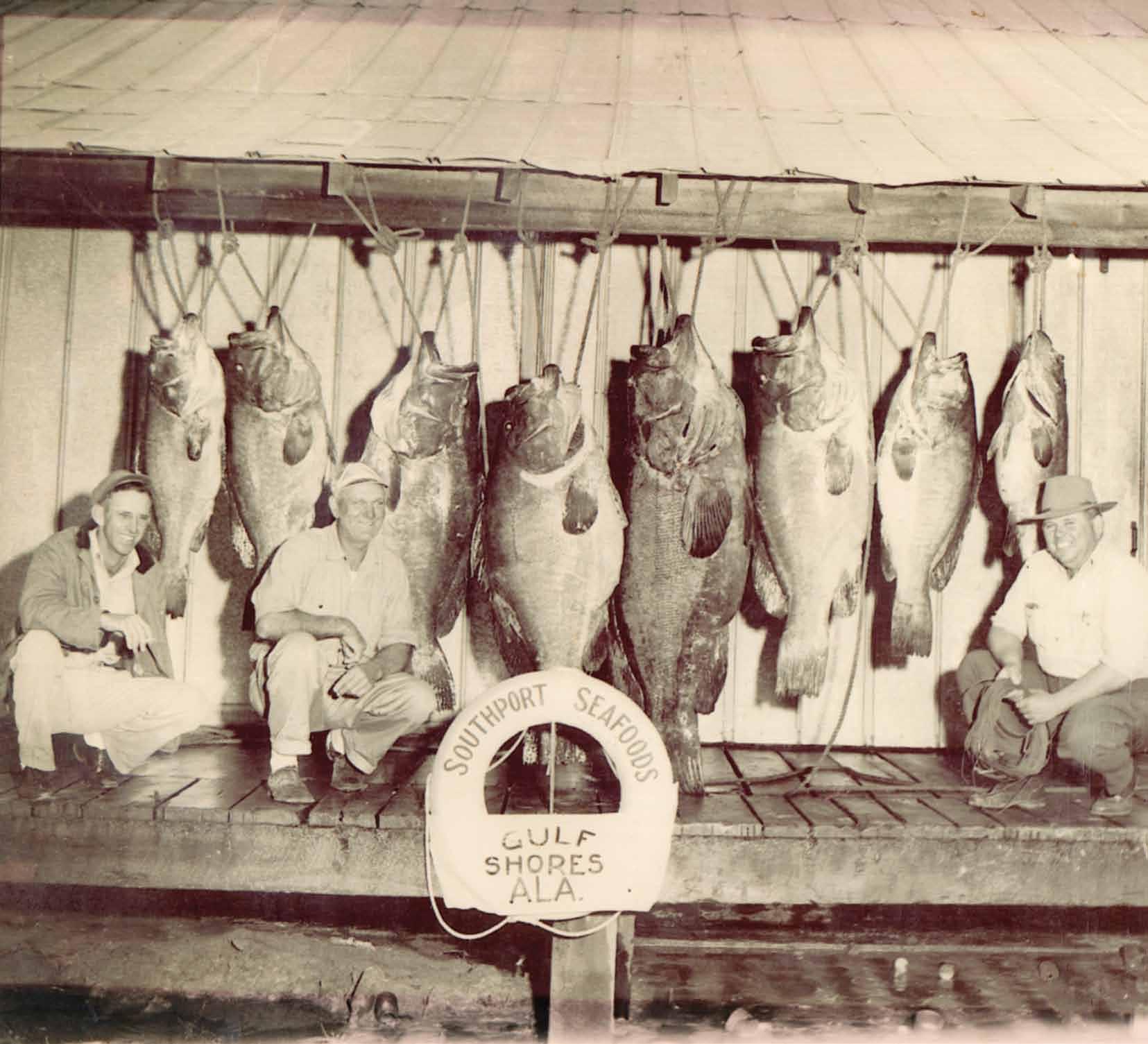

Shrimp Boat Vivian Lee
Being in the fishing industry since the early 1970s, I’ve seen firsthand how everything in Gulf Shores revolved around fishing. My father opened a shop on the north end of what is now Lulu’s, and we worked side by side, repairing boats, building vessels, and keeping the local shrimping fleet going, along with a few others. Fishing wasn’t just a job—it was a way of life that shaped the entire community. Most of the boys played sports around their shrimping schedules because in the summer, they were out on the boats helping their families. If a family was in need, we’d take the boat out, catch a load of fish, and host a fish fry at the Methodist Church to raise money. That’s just how it was—neighbors helping neighbors. Gulf Shores may have grown over the years, but that deep connection to the water and to each other is still at the heart of this town.
—Joe Garris

Pulling in the catch as a shrimper brings up a basket of shrimp caught in the Gulf
City Councilmember (2004-present)


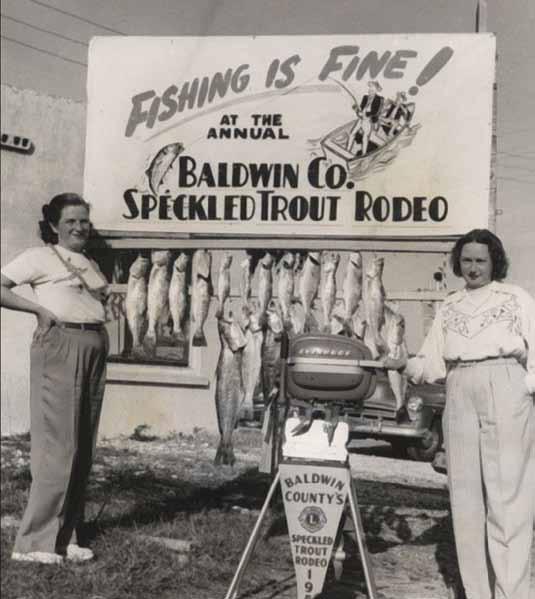
Left: 1963, Lurleen Wallace, the first female Governor of Alabama, presents the Daily Prize Winner trophy to the Speckled Trout Rodeo Champion
Top: 1951, Betty Egbert Holt holding the winning speckled trout Bottom: 1950s, winners Virginia James of Centreville, Alabama, and Virginia Clinton of Florence, Alabama. Prizes included an Evinrude outboard motor.
The Baldwin County Speckled Trout Rodeo began in 1948, and by 1973, it had reached its 25th anniversary, marking a quarter-century of fishing, community camaraderie, and spirited competition. Sponsored by the Gulf Shores Lions Club, this highly anticipated event spanned an entire week in midNovember, drawing anglers eager to showcase their skills in the waters off Gulf Shores, Alabama. More than just a fishing tournament, the rodeo was a true celebration—bringing together locals and visitors for a week of excitement, prizes, and tradition. In addition to the fishing competition, the event featured a beauty contest and even a turkey shoot, making it a highlight of the season.




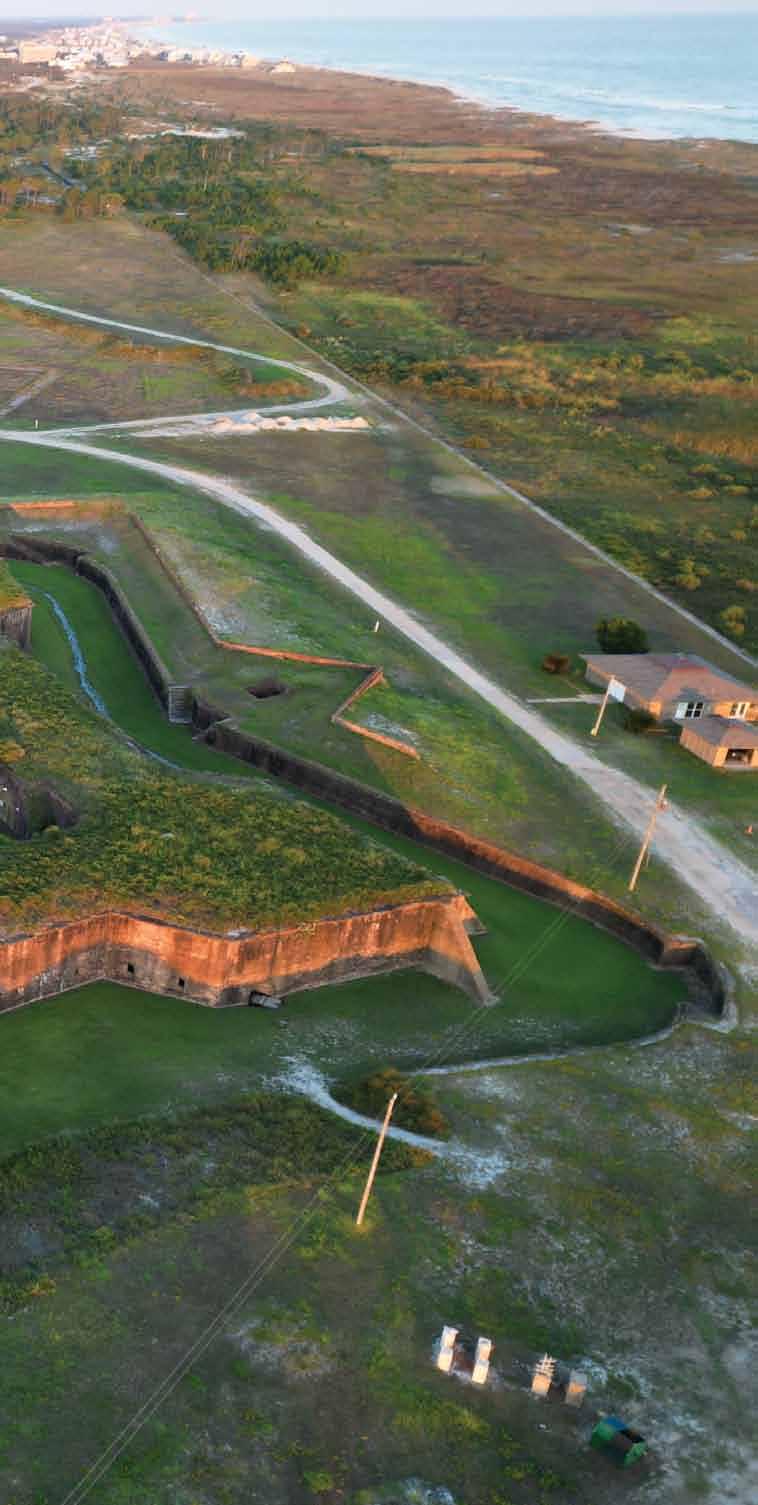
Fort Morgan
Perched at the entrance of Mobile Bay, Fort Morgan stands as a testament to the strategic military history of the Gulf Coast. Constructed between 1819 and 1834, this imposing masonry fortification was named in honor of Revolutionary War hero General Daniel Morgan. Its pentagonal design and robust structure were intended to bolster coastal defenses following the War of 1812.
The Fort’s significance is perhaps most prominently highlighted during the Civil War, particularly in the Battle of Mobile Bay in August 1864. Union Admiral David Farragut led a daring naval assault against Confederate forces, famously declaring, “Damn the torpedoes, full speed ahead!” This decisive engagement led to the Union’s control over Mobile Bay, a critical Confederate port.
Beyond the Civil War, Fort Morgan played roles in subsequent conflicts, including the Spanish-American War and both World Wars. Its strategic position made it a focal point for coastal defense and military training activities. During World War II, enemy submarines patrolled the Gulf of Mexico, threatening vital shipping lanes. Notably, German U-boats, such as U-166, operated in these waters, underscoring the Fort’s continued importance in coastal defense.
The preservation of Fort Morgan owes much to the dedication of William Temple “Hatchett” Chandler. Serving as the Fort’s custodian from World War II until 1957 and as secretary of the Fort Morgan Historical Commission, Chandler was instrumental in developing the site into a historical park. His efforts in restoring the Fort and promoting its history have left an indelible mark, ensuring that visitors today can experience this piece of American heritage.
Today, visitors to Fort Morgan can explore its well-preserved structures, including the original brickwork, artillery batteries, and the museum that houses artifacts spanning its operational years. Walking through its corridors and ramparts offers a tangible connection to the past, providing insight into the Fort’s role in shaping the region’s history. As a designated National Historic Landmark, Fort Morgan serves not only as a monument to military engineering but also as a reminder of the complex narratives that have defined the Gulf Shores area. Its enduring presence continues to educate and inspire, offering a window into the coastal defenses that once stood as the nation’s guardians.

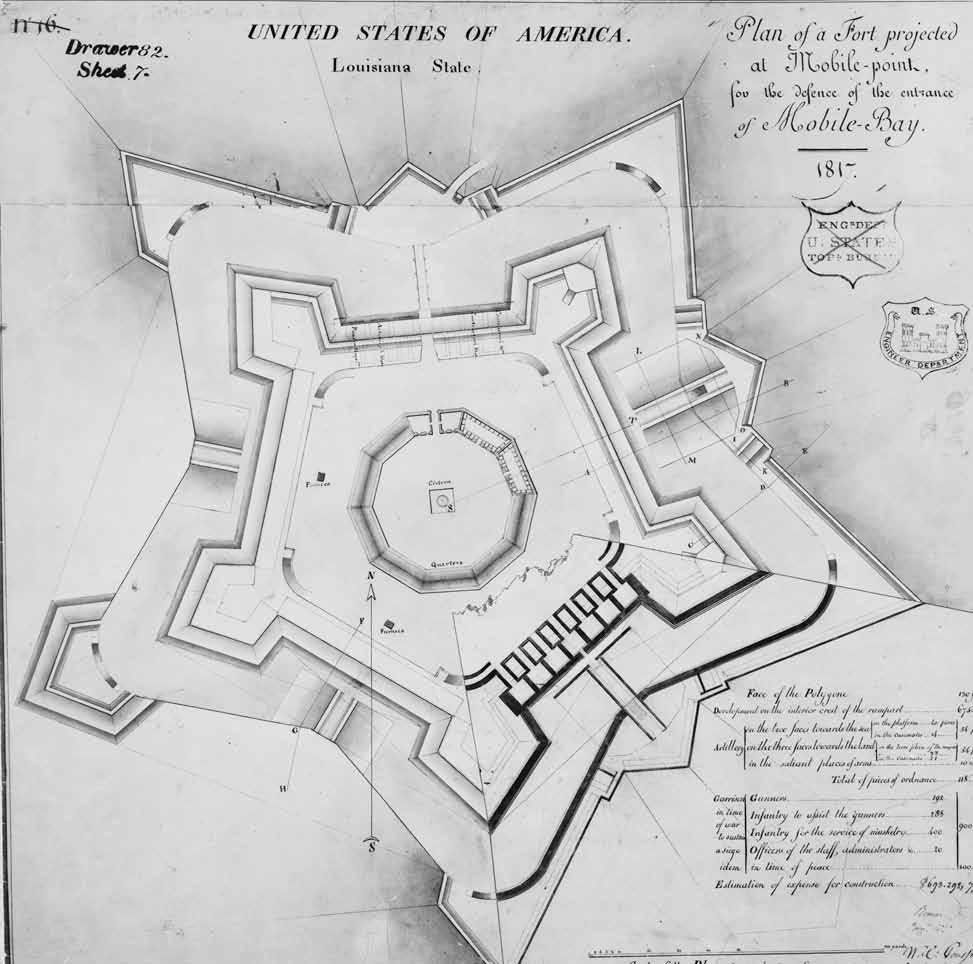

Top left: 2024, aerial of Fort Morgan
Top Right: 1817, “Plan of a Fort projected at Mobile Point”
Bottom:1864, view of parapet, looking north, showing Union Fleet at Mobile Bay

1864, Fort Morgan after the Battle of Mobile Bay

1950s, beach, looking eastward

George C. Meyer A
Founding Visionary
George Charles Meyer, born on September 21, 1878, in Minnesota, was the son of German immigrant parents, Christopher Meyer and Caroline Rosine Sophie Blume. With a spirit of adventure and a dream to create a coastal paradise, Meyer embarked on a remarkable journey that would forever shape the history of Alabama’s Gulf Coast. Meyer’s early life in Le Sueur, Minnesota, gave little indication of the transformative impact he would later have on Baldwin County, Alabama.
Meyer’s vision for Gulf Shores began in 1921 when he established the first homestead south of Little Lagoon in what was then a nearly uninhabited region. Described as a “visionary” and a “man ahead of his time,” he dreamed of building a world-class resort destination rivaling the great spas of Europe. Touring the lush coasts of Florida before heading west to Alabama, Meyer envisioned a family-friendly beach community where people could live, play, and thrive.
Meyer’s foresight extended beyond private development. He was instrumental in the establishment of Gulf State Park, recognizing that state ownership of land would lead to the construction of vital infrastructure. He donated approximately 1,000 acres—about one-sixth of the park’s total area—and provided funds to assist in its development. This effort not only protected the natural beauty of the area but also laid the groundwork for accessibility and sustainable growth.
Access to Gulf Shores in those early days was challenging, restricted to a pontoon barge at the southern end of what was then Highway 3. Despite these limitations, Meyer pressed on, acquiring and developing land to create a thriving community. His wife, Erie Hall Meyer, was equally committed to his dream, and after his passing on February 1, 1959, she continued his work, ensuring the growth of Gulf Shores as a vibrant coastal town.
George C. Meyer’s legacy is an integral part of Gulf Shores. From the land he donated to the dreams he pursued, his vision continues to shape the Community’s foundation. When residents and visitors worship, study, or play in Gulf Shores, they do so on the very soil and sand that Meyer and his family generously provided to help build a better future.
Meyer’s contributions were not only transformational for Gulf Shores but also for Alabama’s Gulf Coast, solidifying his reputation as a humanitarian and visionary whose impact endures to this day. He is laid to rest with his wife, Erie, in a mausoleum at Pine Rest Cemetery in Foley, Alabama. His remains were moved there in the early 2000s, further honoring the legacy of innovation, generosity, and community building he left behind.
Intracoastal Waterway
The creation of the Intracoastal Waterway (ICW) was a milestone in the history of Gulf Shores, reshaping both its geography and its economic future. The waterway was envisioned as part of a broader national effort to develop navigable inland routes along the coast, offering both commercial and recreational opportunities. George C. Meyer played a critical role in bringing the ICW to life. He worked in close collaboration with the federal government, granting a perpetual lease for the necessary land and championing the project’s potential to connect Gulf Shores to state and national resources.
Construction of the ICW was completed in 1937 at a cost of $443,000, drawn from an allocated $600,000 budget. This monumental effort linked Mobile Bay, Bon Secour Bay, and Oyster Bay to Wolf Bay and Perdido Bay, effectively altering the landscape. The new waterway separated two sections of land from the mainland, creating Pleasure Island—now home to Gulf Shores and Orange Beach—and Plash Island, a smaller area named after the Plash family, who were prominent in local shrimping and fishing industries.
While the ICW’s original purpose was to facilitate commercial shipping, enabling barges to transport petroleum, foodstuffs, building materials, and manufactured goods, it has since evolved into a favored route for recreational boating. Today, it stands as both a functional waterway and a testament to forward-thinking initiatives that laid the groundwork for Gulf Shores’ development. Meyer’s efforts to secure the project ensured that Gulf Shores was positioned for growth, connecting the region to vital state and federal resources that spurred its transformation into a thriving coastal community.


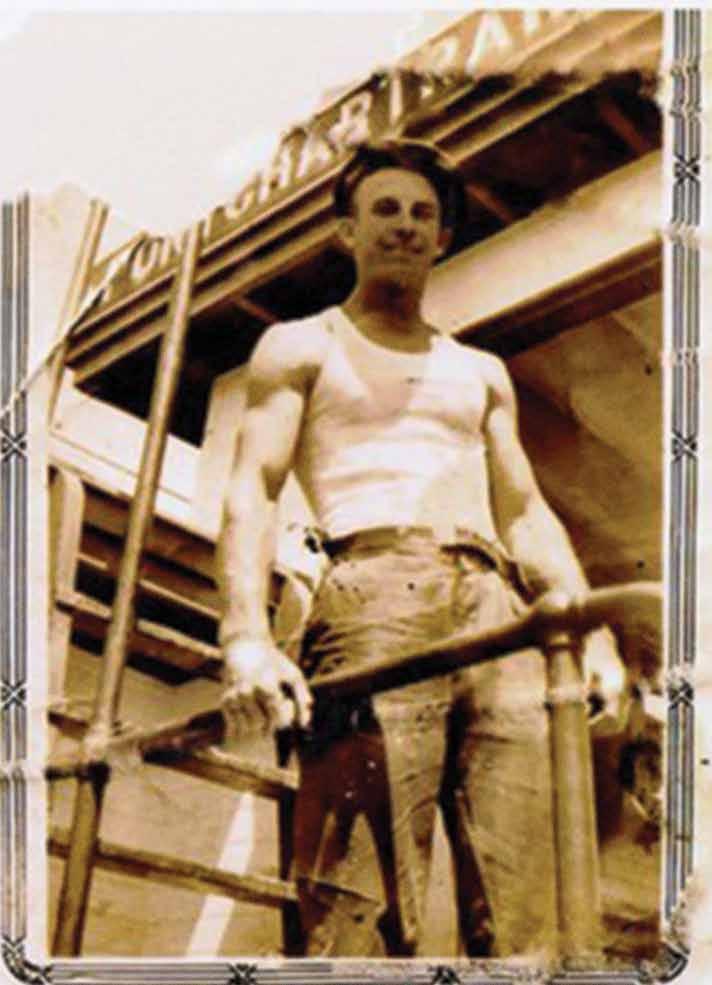

Center: 1933-1937, the Dredge Ponchatrain which was used to build the Canal Top: 1933, Joseph Quilliber working on the Dredge Ponchatrain during the building of the Intracoastal Waterway which opened in 1937
Bottom: 1930s, construction on the Intracoastal Waterway

Above:1980s, originally built for commercial use, the Intracoastal Waterway gradually became a route for recreational boaters alongside commercial barges
Opposite page: 1980s, Intracoastal Waterway, looking westward towards Oyster Bay

